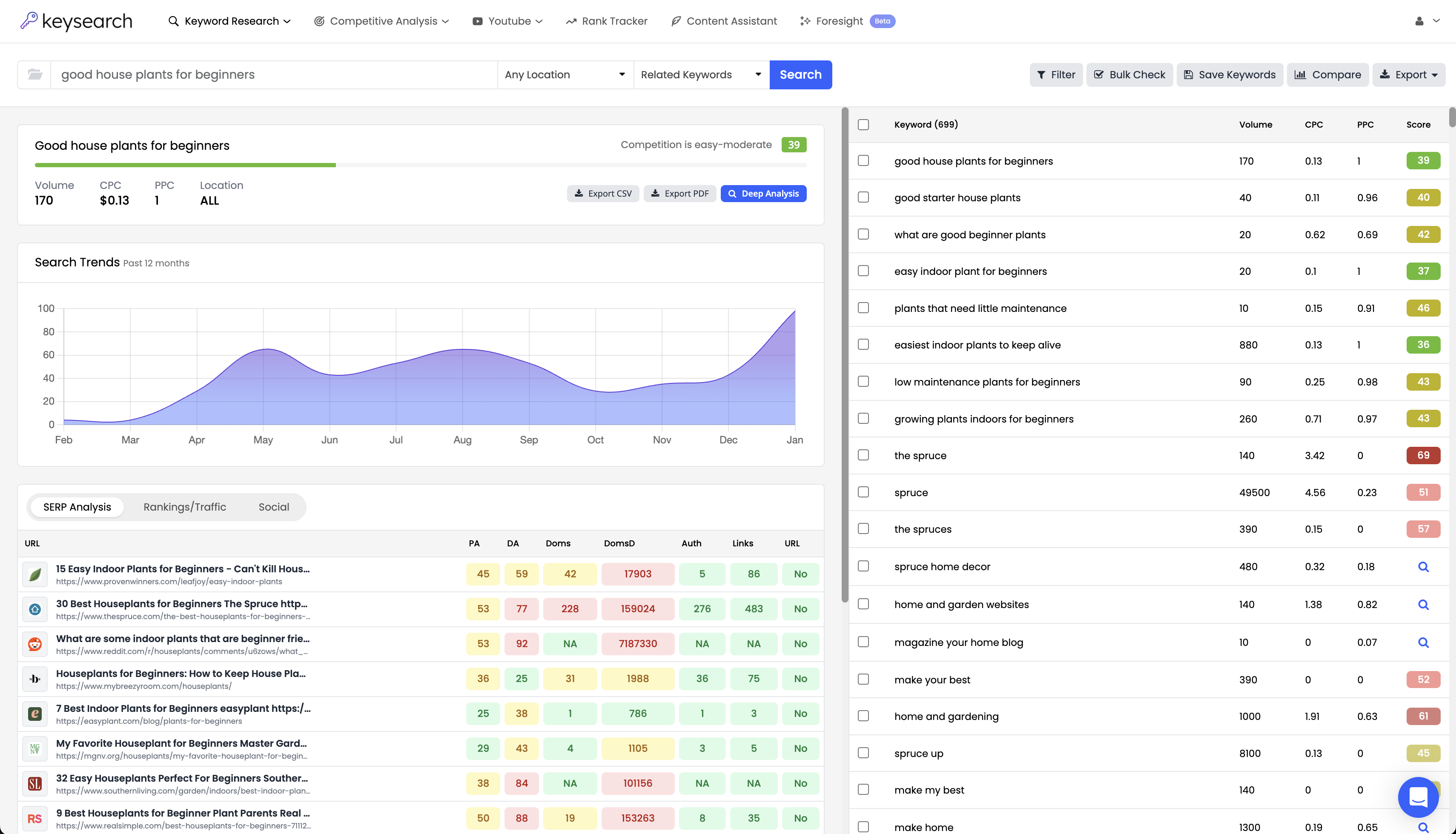Does Keyword Density Still Matter?
It’s safe to say SEO has evolved from its humble beginnings back in the early 2000s. You used to be able to stuff keywords on a webpage with no regard for content quality or readability. It ranked – nobody cared what it looked like!
For better or worse, search engines have become wise to the manipulative practices these SEO pioneers implemented. Algorithm updates like Panda more than a decade ago have reshaped how we optimize websites.
So, does keyword density still matter? Absolutely – just not in the way you might think! It’s not about making sure you have the keyword used X amount of times on a web page. Instead, you want to aim for a conservative density to avoid looking spammy or overstuffing the keyword.
We’ll walk you through the evolution of keyword density below and bring you into the present day for creating high-quality content that ranks.
You’ll also learn how to avoid getting flagged for spammy content with our keyword density tool. This is just one of the many free SEO tools available here at Keysearch, your affordable SEO toolkit to dominate your niche and turn the tap on organic traffic!
What is Keyword Density?
Before we get into the role of KW density today, let’s take a step back and explain what exactly it is. This metric refers to the percentage of times a specific keyword appears in a piece of content relative to the total word count.
It helps search engines understand the relevance of a webpage to a particular search query. The formula to calculate keyword density is:
(Number of times the keyword appears / Total word count) x 100 = KW density.
For example, if a keyword appears 10 times in a 1000-word article, the keyword density is 1%. There’s a balance between ensuring your keyword is prominent enough in the content to be picked up by search engines without coming off as spammy, though.
That being said, does keyword density matter still today?
Does Keyword Density Still Matter?
Maybe you were fortunate enough to play the SEO game back when you could effortlessly rank pages. Competition was slim and algorithms were far less sophisticated.
But times have certainly changed, as the SEO landscape is tougher than it’s ever been. It’s only going to become more difficult, too. Let’s look at how we got here.
Evolution of Search Engine Algorithms
All search engines rely on an algorithm of some sort to guide users towards a solution based on their query. This is true of Google, Amazon, YouTube, Pinterest, and everything in between.
You used to be able to buy an exact match domain for any keyword you wanted to rank for, stuff a few terms in, build some low-quality links, and voila – you’d opened the pipelines on organic traffic.
Google quickly realized its algorithms were being gamed – and in some cases, led to poor user experiences. The search engine will always prioritize user experience over everything else.
So, algorithm updates rolled out one after the other to address these flaws that allowed low-quality websites to take market share.
The first was Panda back in 2011, which rewarded high-quality content and penalized low-quality content. This was quickly followed by the Penguin update that focused on backlinks, which were used as a “pay-to-play” tactic in the SEO realm.
Other noteworthy updates along the way included Pirate, Venice, Hummingbird, and Pigeon. Each played a part in changing the way the game of SEO was played.
Back in 2015, RankBrain was introduced – which served as the first machine-learning component added to Google’s algorithm with the goal of better matching search query intent with SERPs.
This led to the introduction of BERT back in 2019, which brought in natural language processing capabilities to the equation. It was the most sophisticated to date understanding the nuances and context of words in a search query, enabling Google to deliver more relevant results.
The most recent update, and the most relevant for today’s conversation, was the Helpful Content Update, or HCU for short.
This algorithm adjustment is highly contentious as the unfortunate reality is that it hasn’t worked quite as well as Google may have initially intended. Many high-quality sites have lost their entire traffic while low-quality sites slid under the radar and continue to dominate the SERPs.
However, the key takeaway from this overview of the SEO algorithm history is that search engines are now better at understanding the meaning behind content rather than just scanning for specific keywords. So, does keyword density still matter today?
Role of Keyword Density Today
It’s true that keyword density is no longer the sole determinant of search rankings. However, it still plays a role in SEO. Maintaining an optimal keyword density ensures your content is relevant to the search terms you want to rank for.
But, the focus should be on natural language use and context rather than hitting a specific percentage. You don’t need to rely on stuffing keywords to show Google what your content is all about – you just need to do a good job explaining yourself!
The role of keyword density today is less about stuffing keywords to show relevancy to search engines. Instead, it’s a balancing act between making sure your keywords are prominent without stuffing them unnaturally.
So, where’s the sweet spot? We see so many experts suggest a range between 1% and 2%, but we feel this is a bit much. Our target density is between 0.5%-1% max.
This is why checking density before you hit publish is so important – you don’t want your content to get flagged as spammy by the HCU. We’ll show you how to check KW density in a minute. First, let’s look at the other factors that play a bigger role in getting your pages to rank.
Other Influencing Factors
The overarching theme from this conversation is that content may still be king, but the way the king is crowned these days is very different.
Quality matters more than anything else – but how do you gauge quality? It’s a nuanced subject for sure. The content should be informative, engaging, and valuable to users.
We’ll help you create high-quality content with some tips in a moment – here are some of the other important factors to consider:
- User Intent: Your content should answer the queries your audience is searching for. This involves using keywords in a way that matches the searcher’s intent, whether they are looking for information, making a purchase, or seeking specific services.
- User Experience: Page load speed, mobile-friendliness, and intuitive navigation can make or break user experience. A fast, responsive, and easy-to-navigate website keeps users engaged, reduces bounce rates, and sends positive signals to search engines.
- Backlinks: Acquiring links from reputable sites is a strong signal of your content’s authority and relevance. Again, the emphasis here should be links from quality sites rather than the quantity of links. Relevancy matters as well, as does anchor text.
- Technical SEO: Prioritize proper use of meta tags, alt text for images, structured data, and a well-organized site structure. These technical elements help search engines crawl and understand your site more effectively.
- Content Freshness: Search engines favor fresh content, so regularly reviewing and refreshing your pages can help maintain and improve your rankings.
Tips to Avoid Keyword Stuffing and Create High-Quality Content
While keyword density still matters, it’s not necessarily about making sure you have enough usage on a given page. Rather, it’s about preventing stuffing. That’s why you still check density even with today’s algorithms.
That being said, we want to walk you through creating high-quality content below to set you up for success as you seek to dominate the SERPs in your niche.
Focus on User Intent and Providing Value
Before you put pen to paper (or, more aptly, finger to keyboard), consider what your readers are looking for and how your content can meet their needs.
Are they seeking detailed information, product recommendations, or step-by-step guides? Tailor your content to answer these questions comprehensively. Or, perhaps their query more closely aligns with a purchase. You’d then want to create a buyer’s guide or product landing page.
Gauging user intent can be tricky since there isn’t really a metric for it. So, instead, look at what’s ranking in the top 3 spots for a given keyword. These results are usually a good sign of what Google deems to match intent.
Then, it’s just a matter of offering more value than the other sites are. This can be tricky when everyone else is doing a great job, but it’s what separates the best sites from the rest.
Look for gaps in their content and address them. See if you can take complex topics and better explain them. Or, maybe you need to leverage multimedia. There are a number of ways you can go about it.
Use Synonyms and Related Terms
Instead of repeatedly using the same keyword, diversify your language by incorporating synonyms and related terms. This approach, known as Latent Semantic Indexing (LSI), helps search engines understand the context and breadth of your content without over-relying on a single keyword.
We have great LSI keyword tools here at Keysearch to help you streamline this process and effortlessly pull the top LSI keywords for any given topic so you can cover all your bases.
For example, if your primary keyword is “digital marketing strategies,” you can also use phrases like “online marketing techniques,” “internet marketing tactics,” or “web marketing plans.”
On the other hand, our long tail keyword generator reveals lower competition opportunities that you can weave throughout your content as well. These won’t have the same traffic potential but the traffic is more targeted.
A few examples of long-tail variations for “digital marketing strategies” include “b2b digital marketing strategies,” “digital marketing strategies for beginners free,” or “digital marketing strategies for e-commerce”.
Put Keywords Where They Matter Most
You don’t want to overuse keywords, which is why you need to be more meticulous in where you place them – ensuring you’re getting the best SEO bang for your buck. The most important places include:
- Title Tags: This is one of the first things search engines and users see, so include your primary keyword here.
- Headings and Subheadings: Use keywords in your H1 tag and at least one H2 tag. You can consider using LSI and long-tail variations in your other H2 and H3 tags to signal the content’s relevance to both readers and search engines.
- Introduction and Conclusion: Mention your keywords early in the introduction to set the context and reinforce them in the conclusion.
- Meta Descriptions: Compelling meta descriptions with your primary keyword can improve click-through rates from the SERPs.
- Image Alt Text: This can improve the visibility of your content in image searches and enhance accessibility.
- URL Slugs: Make this your exact match keyword.
Use keywords sparingly throughout the body of your content as well. Try to space them out so that you don’t have them jammed all in one single paragraph somewhere.
Leverage a Keyword Density Tool to Avoid Over-Optimization
Take a moment to run your content through a keyword density tool to avoid getting flagged with a penalty for spam. These tools analyze your text and provide a keyword density percentage, allowing you to adjust as needed to avoid over-optimization.
Keysearch offers a free keyword density checker tool to streamline this process. Simply paste your URL into the tool and it will highlight areas where keywords are used too frequently or too sparingly. This helps you strike the right balance, keeping your content SEO-friendly without compromising quality.
It’s just one of many tools you have in your arsenal with a single Keysearch subscription, too. Others include:
- Keyword clustering tool
- Keyword difficulty tool
- Niche tool
- Duplicate content checker
- Etsy keyword generator
- Amazon keyword generator
- eBay keyword research tool
- Pinterest keyword research
- YouTube keyword research tool
Many of these tools are free to start out with. As you scale up your needs you can choose from one of our affordable plans to keep costs low while driving better results over time. So, start uncovering the top keywords on autopilot with Keysearch today!
Parting Thoughts on the Role of Keyword Density Today
So, does keyword density matter still today? Yes, but not in the sense that you need to make sure you’re stuffing enough keywords in – instead, it’s a matter of avoiding over-optimization. The scale has tipped in the opposite direction, and these days, less is more.
While you still need to check keyword density, it’s more important that you’re creating valuable, user-centric content that naturally incorporates keywords. We hope you have a clear understanding of how to do that after reading our tips above.
Our blog has additional insights on Etsy keyword research, Pinterest keyword research, keyword research for YouTube, what is a good keyword difficulty score, keyword research checklist, what to do after keyword research, how to automate keyword research, and more.
Or, you could take a moment to see how Keysearch compares to some of the other SEO toolkits you have at your disposal if you’re still on the fence:
Ultimately, high-quality content that engages and satisfies readers will always perform well. We can help you create it with our tools for uncovering opportunities and assisting in content generation. Discover the Keysearch difference today!
- How to Do Keyword Research for Free: Best Free Keyword Research Tools in 2024 - December 13, 2024
- Benefits of Keyword Clustering: Why is it Important to Group Relevant Keywords Together? - December 13, 2024
- What is Keyword Density in SEO and Its Importance - December 13, 2024







